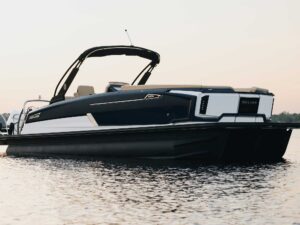Anyone who attempts to tell you what the world will be like in the future should be forced to take a long embarrassing look at what the consensus was for 2001 back in the ’30s. As you might have noticed, we have no personal gyrocopters, cities in bubbles, kitchen robots, or flying boat service to Rio. Futurama never happened. Predictions are usually wrong because we see tomorrow from today’s perspective-which is always left behind.
That said, here are my divinations for boats in the year 2011. Prepare to be astounded, amazed, and, in 10 years, to have a good laugh at my expense. The one thing that makes this easier is that boats don’t change much. That’s because the sea doesn’t change much either, and boaters are notoriously conservative-and rightfully so.
The one thing that makes predicting easier is that boats don’t change much. That’s because the sea doesn’t change much either, and boaters are notoriously conservative-and rightfully so. All of which plays into a trend called “down aging,” where Boomers find comfort from products similar to those of their youth. Why change when the past is so appealing? The old-is-new thing is gaining momentum and will not be just for 40-somethings. At the Miami Boat Show, a young guy, hypnotized by a retro-styled Chris-Craft Roamer, said, “Now that looks like a boat.” And four guys of different ages nodded in agreement. Expect builders to look to their past to find the future. Maybe with reworkings of classics such as the Bertram Moppie and Century Coronado.
Old hull types will also come back. When they were conceived, the available technology often couldn’t support them. For example, it took almost 90 years for the stepped hull to become mainstream. The hydrofoil, a concept championed by Alexander Graham Bell that made 70 mph in 1918 and enjoyed a brief but failed revival in the ’50s, was another good idea too soon. But its time is near. Anyone who has seen the Navy’s foil tear out of Key West to go after smugglers knows that they work. Right now, catamaran builders in South Africa are successfully using foils between the hulls.
Ground effect (GE) is a relatively new idea. By trapping air between water and stubby wings you get lift from the increased pressure. This is in contrast to an airplane that gains lift from a decrease in pressure on the upper surface of its wings. GE craft need little power to go fast and carry large loads. The military uses them, and the technology is filtering down to us. The Coast Guard has recently ruled that GE craft are boats, not airplanes. So you won’t need a pilot’s license.
Fifty years ago, fiberglass, denigrated by wood boatbuilders as looking like “frozen snot,” began its march to dominance. The next wonder material may be rotomolded plastics. Today, it’s where fiberglass was in the ’50s, and it has the same potential: almost unbreakable, easy to repair, and, once the systems are in place, inexpensive to manufacture. The successful line of Triumph (formerly Logic) Boats is leading the way in the U.S. Look for more and bigger models.
We will have semi-custom boats built through modular components. Glastron got into modular design in the mid-’90s, primarily to save costs. A Dutch builder of cruisers has now adapted the idea so customers can mix and match components that drop into place. In the auto industry, Visteon is developing a technology that will let you design your own auto dashboard. Levi offers custom jeans. Why not do the same with boats?
Your electronics package will become seamless, going about its job so well you won’t notice it. A good start is Teleflex’s MagicBus system that promises to intertwine all controls, gauges, and navigation instruments into one easy-to-use system. By 2011 this will be standard on most boats. There will be one screen for information, one control lever for speed and direction.
Of course, none of this may ever happen. But one thing I can promise is that the boat shown here will never be built. Done by design students, it’s classic Futurama thinking. But it’s still fun to look at, and some of its elements might just make it-especially that hydrofoil hanging underneath.









